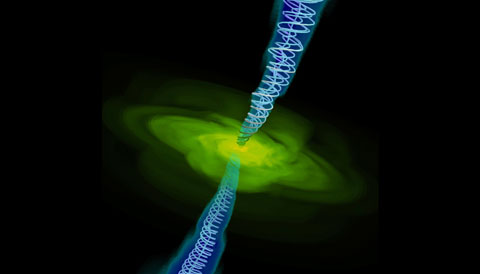Newly published observations provide the first real evidence supporting a theory that tells us how black hole jets form.

NASA / The Hubble Heritage Team (STScI / AURA)
Jets are fascinating creatures. Astronomers see them wherever gas accretes onto compact objects, such as newborn stars or black holes. They can even film them: a long-lived Hubble program has been watching for years as plasma slowly works its way down M87’s 5,000 light-year-long jet.
But start asking some basic questions about jets and you’ll find mass confusion. How do jets form? What accelerates the flow? What is the flow? Even the most fundamental aspects are still open to debate.
The latest theory to make the rounds, known as the magnetically arrested disk (MAD), could help answer some of these questions. A landmark theoretical study showed that a highly magnetized disk that encircles a spinning black hole could easily power jets. Now Mohammad Zamaininasab (Max Planck Institute for Radio Astronomy, Germany) and colleagues have published the first observations to support this theoretical picture in the journal Nature.
MAD Jet Generation
It’s easy for a black hole to grow a magnetic field. Hot, ionized gas spirals through an accretion disk before entering the gaping maw, and all those speeding protons and electrons generate magnetic fields that thread the disk like giant loops of spaghetti. As the black hole feeds on the gas, it slurps in the spaghetti too — but simulations show black holes have a limited appetite for carbs.

Alexander Tchekhovskoy / LBL
In the simulations, gas flowing in from the outer disk carries with it more and more magnetic field lines. Soon the pressure exerted by the pile-up of magnetic pasta blocks the inward flow of gas. Accretion never completely stops, but the magnetic barrier puts the black hole on a severe diet.
So where does the trapped gas go? If the black hole is spinning even a moderate amount, it will twist the magnetic fields into a helix, creating a giant generator capable of launching gas outward in streams traveling nearly the speed of light. In other words, combine strong magnetic fields with a spinning black hole and jets are the natural outcome.
Putting Theory Into Practice
Astronomers can’t currently map the regions surrounding black holes to the degree necessary to test this theory with direct observations (though they’re coming close). So Zamaninasab’s team took an indirect approach.
MAD theory predicts that the magnetic energy flowing through the jet should relate in a specific way to the luminosity of the accretion disk. So Zamaninasab and colleagues measured these quantities for a sample of 76 galaxies, each of featuring a supermassive black hole at its core and a radio-emitting jet, and found exactly the relation predicted by MAD theory.
“The MAD idea has become popular among a handful of key theorists, but this is the first observational support that it has received,” explains Alan Marscher (Boston University). The study’s authors go a step further, calling the tight correlation they observe “direct observational evidence” of the theory.
But a word of caution: both quantities that the team measured, the flow of magnetic energy and the brightness of the accretion disk, would be related even if the MAD theory weren’t correct. “The correlation shown [in the paper] looks so nice because both quantities depend strongly on the mass of the black hole,” Marscher says. That’s not to say the relation isn’t real — it still holds even if black hole mass is taken into account — but it’s weaker than it first appears.
If MAD jet-formation theory is correct, then the key factor in determining whether a black hole makes jets is not so much its spin, but its magnetic field. This has direct relevance closer to home: recent evidence has found that the Milky Way’s own supermassive black hole is surrounded by a strong magnetic field. That may be responsible for its current starvation diet, which would mean current models of its accretion would have to be revised.
Reference:M. Zamaninasab et al. "Dynamically Important Magnetic Fields Near Accreting Supermassive Black Holes," Nature, 5 June 2014.
Black holes are fascinating creatures in their own right. If you're curious to learn more, download our free e-book today!
 0
0









Comments
You must be logged in to post a comment.